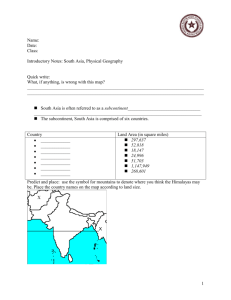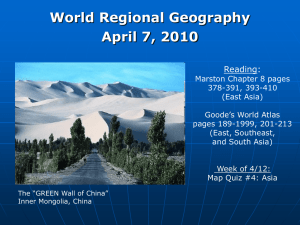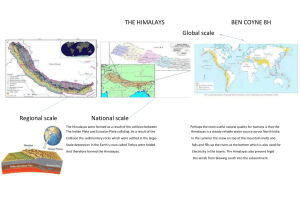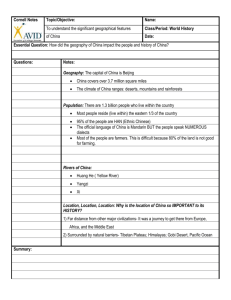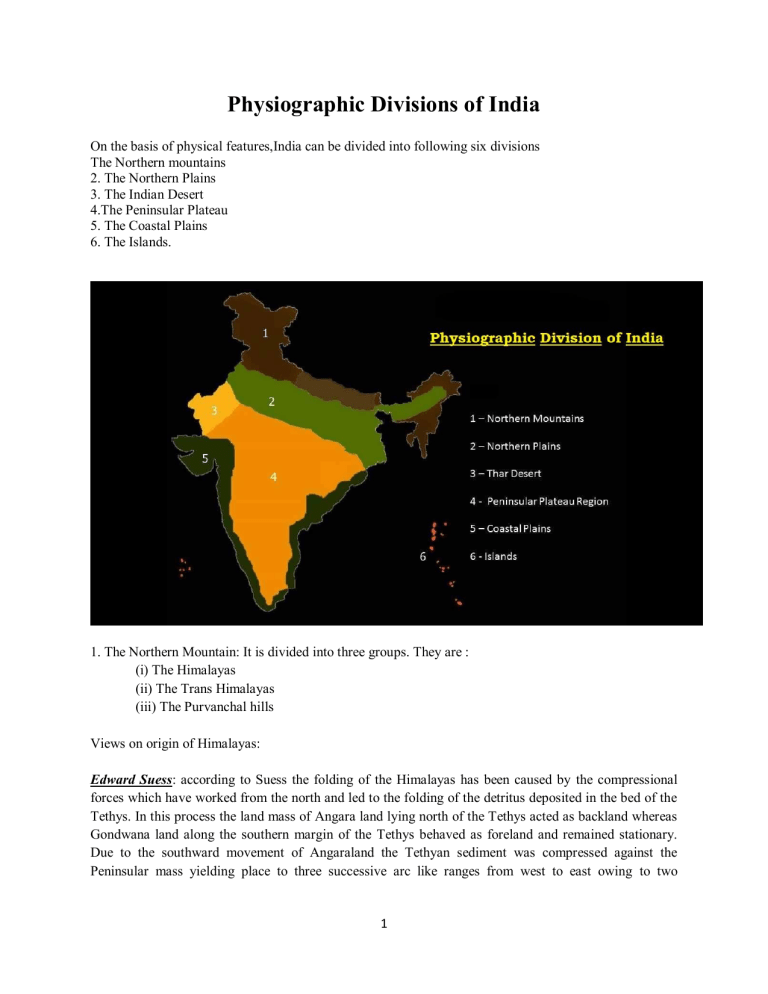
Physiographic Divisions of India
On the basis of physical features,India can be divided into following six divisions
The Northern mountains
2. The Northern Plains
3. The Indian Desert
4.The Peninsular Plateau
5. The Coastal Plains
6. The Islands.
1. The Northern Mountain: It is divided into three groups. They are :
(i) The Himalayas
(ii) The Trans Himalayas
(iii) The Purvanchal hills
Views on origin of Himalayas:
Edward Suess: according to Suess the folding of the Himalayas has been caused by the compressional
forces which have worked from the north and led to the folding of the detritus deposited in the bed of the
Tethys. In this process the land mass of Angara land lying north of the Tethys acted as backland whereas
Gondwana land along the southern margin of the Tethys behaved as foreland and remained stationary.
Due to the southward movement of Angaraland the Tethyan sediment was compressed against the
Peninsular mass yielding place to three successive arc like ranges from west to east owing to two
1
extended horns of the peninsula (the Aravallis and Delhi ridge in the west and Meghalaya plateau in the
east).
The southward bend in the Himalayan ranges is cited as a strong argument in support of this
theory.
Kober: famous german geologist Kober has presented a detailed and systematic description of the surface
features of the earth in his book ‘Der Bau der Erde’ in which he has tried to establish a relationship
between ancient rigid masses and orogeny (mobile zones or geosynclines).
Thus he has tried to explain the origin of mountains on the basis of his geosynclinals theory. According to
this theoryTethys geosyncline occupied the present day place of the Himalayas and was bordered by
Angaraland in the north and Gondwanaland in the south both of which acted as foreland.
During the Eocene period both these rigid masses (kratogens) started converging as a result of
which folds were formed along the northern and southern borders of the Tethys sediments giving birth to
the Kunlun mountains in the north and Himalayas in the south.
Tibetan plateau as median mass between these two mountains remained unaffected by the
folding, althoughit was slightly raised due to intense nature of the compressional forces.
(i) The Himalayan Mountains Himalayas are the young fold mountains. They run from west-east
direction from Indus to Brahmaputra covering a distance of 2500 KM. Their width varies from 400 in the
west and 150 KM in the East. The Himalayas may be divided into three parallel ranges:
(a) Greater Himalayas or Himadari
2
(b) Lesser Himalayas or Himachal
(c) Outer Himalayas or Siwaliks.
(a) The Greater Himalayas or Himadari:
- northern most ranges and peaks.
- average height of 6000 metres and width lies between 120 to 190 Kms .
- It has high peaks like Mt. Everest, Kanchenjunga, Makalu, Dhaulagiri, Nanga Parbat etc. Mt.
Everest (8848 m) is the highest peak of the world and Kanchenjunga is the highest peak of
Himalaya in India.
- passesexist in this range, namely, Bara Lacha-La, Shipki-La, Nathu-La, Zoji-La etc.
- The Ganga and Yamuna rivers originates from this Himalayas.
(b) The Lesser Himalayas or Himachal:
- height 1000 and 4500 metres
- average width is 50 KM.
- ranges in this are PirPanjal, DhaulaDharand Mahabharata ranges.
- hill stations like Shimla, Dalhousie Darjeeling, Chakrata, Mussoorie, Nanital etc.
- valleys like Kashmir, Kullu, Kangra etc.
(c) The Outer Himalayas or the Siwaliks: outer most range of the Himalayas.
- height varies from 900-1100 meters and the width lies between 10-50 KM.
- valleys lying between Siwalik and Lesser Himalayas (Himachal) are called ‘Duns’ like Dehra
Dun, Kotli Dun and Patli Dun.
(ii) The Trans-Himalayan ranges: It extends north of greater Himalaya and parallel to it is called zaskar
range. North of Zaskar range liesLadakh range. The Indus river flows between Zaskar and Ladakh range.
The Karakoram range lie extreme north of the country. K2 is the second highest peak of the world.
(iii) The Purvanchal hills: It comprises Mishami, Patkoi, Naga, Mizo hills which are located in eastern
side. The Meghalaya plateau is also part of these hills which includes the hills of Garo, Khasi and Jaintia.
Divisions of Himalayas
There are four main divisions of Himalayan Mountain Ranges which are separated from one another by
the gorges of rivers which pass through them.
The Punjab Himalayas: The section between the Indus and the Satlej is known as the Punjab
Himalayas. It is also called Jammu-Kashmir and Himachal Himalaya because most of this section is
located in these two states. This section is 560 kilometers long. The important ranges of this section are
the Ladakh, the PirPanjal, the Dhauladhar and the Zaskar. The Zoji La pass is at an altitude of 3,444
meter above the sea-level.
The Kumaon Himalayas: This section runs for a distance of 320 kilometers between the Satlej and the
Kali rivers. This is higher than the Punjab Himalayas. Great rivers like Ganga and Yamuna have sources
in the Kumaon Himalayas.
3
The Nepal Himalayas: This is situated between the Kali and the Tista rivers and is 800 kilometers long.
Most of it is located in Nepal and hence its name. This is the highest part of the Himalayas where lofty
peaks like the Everest, the Kanchenjungha, the Dhaulagiri, the Annapurna, and the Makalu etc. are
located. The flat Kathmandu valley is also situated in the Nepal Himalayas.
4. The Assam Himalaya: It extends for a distance of 720 kilometers between the river Tista and the
Dihang (Tsangpo-Brahmaputra).
Significance of the Himalaya Mountains to India
1.
2.
3.
4.
5.
6.
7.
8.
9.
10.
Climatic Influence,
Defence
Source of Rivers
Fertile Soil
Hydroelectricity
Forest Wealth
Agriculture
Tourism
Pilgrimage
Minerals
4
2. The Northern Plain:
Origin
•
•
•
The Great plain of Northern India was formed by the sediments brought down by the IndusGanga-Brahmaputra and their tributaries and it is popularly known as the Indo-GangaBrahmaputra plain
Geologists suggest that there was a shallow trough or geosyncline in between the Himalayas and
the Deccan plateau during the latter geological period of the formation of the Himalayas.
After the upliftment of the Himalayas, sediments and debris brought down by the rivers, began to
accumulate there to form the vast alluvial plain of northern India.
Northern plains
- located between south of the Himalayas and north of the Peninsular plateau.
- formed by the deposition of the sediments brought by three main river systems namely : the Indus, the
Ganga and the Brahmaputra.
- 2400 km long and its width varies from about 300 km in the west to about 150 km in the east.
- It mainly includes the states of Punjab, Haryana, Uttar Pradesh, Bihar, West Bengal and Assam.
- plain is one of the largest and most fertile plains of the world. Major crops such as wheat, rice,
sugarcane, pulses, oil seeds and jute are grown here.
Bsed on relief features the northern plain can be divided into following region:
i.
Bhabar- after descending from the mountains, the rivers deposit pebbles in a narrow belt. The
width of this belt is about 8-16 km and it lies parallel to the Shiwaliks. This region is known
as bhabar. All the streams dissappear in this region.
ii.
Terai: lies towards south of bhabar belt. In this regiaon, the streams reappear and make awet,
swampy and marshy region.
iii.
Bhangar: largest part of northern plainand is composed of the oldest alluvial soil. They lie
above the flood plains and resemble terraces. The soil of this region is locally known as
kankar and is composed of calcareous deposits.
iv.
Khadar: the floodplains formed by younger alluvium are called khadar. The soil in this
region is renewed every year and is thus highly fertile.
Regional division of northern plains:
i.
Punjab plains: it forms the western part of the northern plains. This is formed by the Indus
and its tributaries like Jhelum, Chenab, Ravi, Beas, Sutlej. A major portion of this plain is in
Pakistan. Doabs abound in this plain.
ii.
Ganga plain: this plain extends between Ghaggar and Tista rivers. The northen states,
Haryana, UP, Delhi, Bhar, Part of Jharkhand and West Bengal lie in the Ganga Plains.
iii.
Bramaputra plains: this plain forms the eastern part of the northern plai and lies in Assam,
Significance of the Great Plains:
5
The northern plains is a riverine region, being bountifully endowed with the fertile soil, favourable
climate, flat surface rendering possible the construction of roads and railways, and slow moving rivers.
All these factors have made this plain very important. An extensive system of irrigation, developed on the
tributaries of the Satluj, the Ganga, the Jamuna and others, has turned the once dreary and desolate tracts
of Punjab, Haryana, northern Rajasthan and Uttar Pradesh, into populous spots of smiling plenty.
(a) Heavy Concentration of Population:
The five rich states of the plain (Punjab, Haryana, Uttar Pradesh, Bihar and West Bengal), support one of
the densest populations in the world.
(b) Cultural and Political Importance:
It is the dominant area from which not only the political power but also economic and cultural movements
spread to Aryavarta. Delhi, Patna and Kolkata have served as the political capitals of the country.
(c) Social and Religious Significance:
IThe Ganga has been the sacred river par excellence and the area from Gaya to Mathura, from Sangam to
Haridwar, is recognised by everyone as the ‘holy land of Hinduism’. Here flourished the religions of
Buddha and Mahavira and the movements of Bhakti and Sufism.
(d) Economic Significance:
The plains have a fertile soil, prrenialriversandfavourable climate they are, the great agricultural tracts of
the country, raising bumper crops of rice, wheat, oilseeds, sugarcane, tobacco and jute. people have
developed a great diversity of occupations, commercial and industrial.
3. The Peninsular Plateau
Peninsular plateau is a triangular shaped table land. It is part of ancient land mass called Gondwana level.
It covers an area of nearly 5 lakh sq.km. It is spread over the states of Gujarat, Maharashtra, Bihar,
Karnataka and Andhra Pradesh.
River Narmada divides the peninsular plateau into two parts:
(i)
The central highlands and
(ii)
(ii)Deccan Plateau
(i)
(ii)
The central Highlands:
extends from Narmada river and the northern plains.
Aravallis is the important mountain which extends from Gujrat through Rajasthan to Delhi.
The Malwa Plateau and Chhota Nagpur plateau are parts of the central highlands.
Important River Betwa, chambal and Ken
Mahadeo, Kaimur and Maikal are the important hills of chhota Nagpur plateau.
The valley of Narmada is lies between the Vindhyas and the satpura which flows east to west
and joins the Arabian sea.
The Deccan Plateau:
- Deccan plateau is separated by a fault fromChota Nagpur plateau.
- The black soil area in the Deccan plateau is known as Deccan trap.
- formed due to volcanic eruptions and good for cotton & sugarcane cultivation. The Deccan
plateau is broadly divided into:
6
(a) The Western Ghats
(b) The Eastern Ghats
-
-
(a) Western Ghats:
runs parallel to the western coast for about 1600 km.
average elevation of the Western Ghats is 1000 metres.
Peaks:Doda Betta, AnaimudiamdMakurti.
Western ghats are continuous and can be crossed through passes like Pal Ghat, ThalGhot and
BhorGhat.
rivers :Godavari, Bhima and Krishna flow eastward while the river Tapti flows westward.
(b) The Eastern Ghats:
discontinuous low belt.
elevation is 600 m.
They run parallel to the east coast from south of Mahanadi valley to the Nilgiri hills.
The famous hills are Mahendragiri hills, Nimaigiri hills in Orissa, Nallamallai hills in
Southern Andhra Pradesh, Kollimalai and Pachaimalai in Tamilnadu.
The area is drained by the Mahanadi, Godawari, Krishna and Kaveri river systems. The
Nilgiri hills join Western & Eastern Ghats in the south.
4. The Indian Desert:
-
lies towards the western margin of Aravali Hills.
called Thar Desert.
It is the ninth largest desert in the world.
Dotted with dunes and barchans
It spreads over the states of Gujarat and Rajasthan.
This region has semi-arid and arid weather conditions. It receives less than 150 mm of
rainfall per year.
The vegetation cover is low with thorny bushes.
Luni is the main river in this area.
7
5. The Coastal Plains
The coastal plains in India run parallel to the Arabian Sea & Bay of Bengal along the Peninsular Plateau.
- The western coastal plain is a narrow belt along the Arabian sea of about 10-20km wide. It
stretches from Rann of Kachchh to KanyaKumari. Western coastal plains comprises of three
sectors
(i) Konkan Coast (Mumbai to Goa),
(ii) Karnataka coast from Goa to Mangalore
(iii) Malabar Coast (Mangalore to KanyaKumari).
- The eastern coast runs along Bay of Bengal.
It is wider than the western coastal plain.
Its average width is about 120Kms.
The northern part of the coast is called Northern Circar and the southern part is called
Coromandal Coast.
Eastern coastal plain is marked by Deltas made by the rivers Mahanadi, Godavari,
Krishna amdKaveri.
The Chilka largest salt water lake in India in Odisha is located to the south of Mahanadi
Delta.
The coastal plains are belts for growing spices, rice, coconut, pepper etc. They are
centres of trade & commerce. The coastal areas are known for fishing activities, therefore
large number of fishing villages have developed along the coasts. Vembanad is famous
lagoon which is located at Malabar coast.
8
6. The Islands
India has two main groups of Islands.
-There are 204 islands in Bay of Bengal called as Andaman and Nicobar islands
-The Andaman & Nicobar island extend from north to south in Bay of Bengal.
- They are bigger in size.
An active volcano is located on the Barren Island in Andaman & Nicobar group of islands.
- 43 islands in Arabian Sea called as Lakshadweep islands
- Lakshadweep islands are located near Malabar coast of Kerala in the Arabian sea.
- They cover an area of 32 sq km.
-Kavarati is the capital of Lakshdweep.
-These islands are formed by corals and endowed with variety of flora and fauna.
9
India: Himalayan and Peninsular Drainage
10
The Himalayan drainage system: Nature and characteristics
•
drained by 19 major rivers, of which the Indus and the Brahmaputra are the largest, each
having catchment basins in the mountains of about 260,000 square km in extent.
•
Five of the 19 rivers, with a total catchment area of about 132,000 square km belong to
the Indus system—the Jhelum, the Chenab, the Ravi, the Beas, and the Sutlej—and
collectively
define
the
vast
region
divided
between Punjab state
in India and Punjab province in Pakistan.
•
Of the remaining rivers, nine belong to the Ganges system—the Ganges, Yamuna,
Ramganga, Kali (Kali Gandak), Karnali, Rapti, Gandak, Baghmati, and Kosi rivers—
draining roughly 218,000 square km)in the mountains.
•
three belong to the Brahmaputra system—the Tista, the Raidak, and the Manas—
draining another 184,000 square km in the Himalayas.
•
Mainly comprises the basin areas of the Indus, the Ganga and the Brahmaputra.
•
the rivers are perennial in nature and are fed by rains during monsoon season as well as
by the melting of the snow during summer season.
•
rivers are in their youthful stage
•
carving out a number of erosional features like deep gorges, V-shaped valleys, rapids
and water falls.
•
Himalayan Rivers, which now belong to the three principal systems (the Indus, the Ganga
and the Brahmaputra), have evolved through a long period of geological history.
•
They originate on the southern slopes of the Tibetan Highlands and first flow parallel to
the main axis of the mountains in longitudinal troughs.
•
They take a sudden bend towards the south carving out deep gorges across the mountain
ranges to reach the northern plains of India. Such deep gorges by the Indus, Satluj,
Alaknanda, Gandak, Kosi and Brahamaputra suggest that they are older than the
mountains themselves and have antecedent characteristics.
11
EVOLUTION OF THE HIMALAYAN DRAINAGE
•
There are differences of opinion about the evolution of the Himalayan Rivers.
•
However, geologists believe that a mighty river called Shiwalik or Indo-Brahma
traversed the entire longitudinal extent of the Himalaya from Assam to Punjab and
onwards to Sind, and finally discharged into the Gulf of Sind near lower Punjab during
the Miocene period some 5-24 million years ago .
•
The remarkable continuity of the Shiwalik and its lacustrine origin and alluvial deposits
consisting of sands, silt, clay, boulders and conglomerates support this viewpoint.
•
It is opined that in due course of time IndoBrahma River was dismembered into three
main drainage systems:
(i)
the Indus and its five tributaries in the western part;
(ii)
the Ganga and its Himalayan tributaries in the central part
(iii)
eastern part
the stretch of the Brahmaputra in Assam and its Himalayan tributaries in the
•
. The dismemberment was probably due to the Pleistocene upheaval in the western
Himalayas, including the uplift of the Potwar Plateau (Delhi Ridge), which acted as the
water divide between the Indus and Ganga drainage systems.
•
Likewise, the down-thrusting of the Malda gap area between the Rajmahal hills and the
Meghalaya plateau during the mid-pleistocene period, diverted the Ganga and the
Brahmaputra systems to flow towards the Bay of Bengal
1. The River Indus:
River Indus rises in Tibet
It flows in north-west direction from its source (Glaciers of Kailas Range – Kailash
range in Tibet near Lake Manasarovar) till the Nanga Parbhat Range.
After entering Jammu and Kashmir through a picturesque gorge, it flows between
the Ladakh and the Zaskar Ranges. It flows through the regions of Ladakh, Baltistan
and Gilgit.
Several tributaries like the Zaskar, the Shyok and the Huzanajoin it here.
It flows through Baltistan-the Gilgit and emerges from the mountain of Attock.
Famous five rivers of Punjab-the Sutlej, the Beas, the Ravi, the Chenab and the Jhelummeet the Indus a little above Mithankot in Pakistsn.
12
After this the Indus river flows southwards and ultimately meets the Arabian Sea.
The total length of the river is about 2900 km.
Nearly 33.3%the Indus basin is located in India in the states of Jammu and Kashmir,
Himachal Pradesh and the Punjab and 67% is in Pakistan.
According to the provision of Indus Water Treaty (1960) India can use only 20% of the
total water carried by the river system.
This water is used for irrigation in Punjab, Haryana, and western parts of Rajasthan.
13
2. The Ganges River System
3.
The Ganga is the largest river of the Indian subcontinent, flowing east through the
Gangetic plain of Northern India into Bangladesh.
The Ganga, 2500 km l ong river rises in the Gangotri Glacier.
From north Ganga is joined by numerous tributaries like the Yamuna, Gomati, the
Ghaghara, the Gandak and the Kosi.
River Yamuna rise fronYamunotri glacier in the Himalayas. It flows parallel to
Ganga and is right bank tributary which joins Ganga at Allahabad.
Ghaghara, the Gandak and the Kosi rise in Nepal Himalayas. These rivers flood
parts of the northern plain every year, causing widespread havoc but enriching
the soil for extensive agricultural lands of northern plain.
The main tributaries coming from the peninsular uplands, are the Chambal, the Betwa,
Son and theDamodar. They rise from semi arid areas and have shorter courses and do not
carry much water in them.
Ganga flows eastwards till Farakka in West Bengal. This is the northern most point of
Ganga delta. The river bifurcates here
i.
The Bhagirathi-Hoogly (distributary) flows southward through the deltaic plains
to the Bay of Bengal.
ii.
The mainstream flow southward into the Bangladesh and it is joined by
Brahmaputra. It is known as Jamuna here. Further downstream it is known as
Meghna
Further this mighty river, with waters from Ganga and the Brahmaputra flows into the
Bay of Bengal and forms the Sunderban delta (largest delta of the world)..
14
3. The Brahmaputra River System
Brahmaputra rises in Tibet, east of Mansarowarlake very close to the sources of Indus
and Sutluj.
In Tibet it is known by the name, Tsang Po.
It is slightly longer than Indus and most of its course lies in Tibet.
It flows eastward parallel to the Himalayas to its south.
When it reaches mountain peak of NamchaBarwa (7757m) it takes a ‘U’ turn and makes
a 5500m deep gorge.
After this it enters India in Arunachal Pradeshthrough a gorge. Here it is called as Dihang
and is joined by Dibang, the Lohit, Kenula and numerous other tributaries to form the
Brahmaputra in Assam
In Tibet Tsangpo river carries a smaller volume of water and less silt as it is a
comparatively dry and hard rocked area.
In India it passes through a region, which receives a huge amount of rainfall. The result is
that the river carries a large volume of water and considerable amount of silt.
15
The Brahmaputra has a braided channel in its entire length in Assam, with numerous
riverine islands.
Every year during the rainy season, Brahmaputra river floods its banks and causes
widespread devastation in Assam and Bangladesh.
The river also shifts channels during rainy season every year.
16
Peninsular drainage system
Evolution of the Peninsular Drainage
Theory 1
•
Geologists believe that the Sahyadri-Aravali axis was the main water divide in the past.
•
According to one hypothesis, the existing peninsula is the remaining half of bigger
landmass.
•
The Western Ghats were located in the middle of this landmass.
•
So one drainage was towards east flowing into Bay of Bengal and the other towards west
draining into Arabian Sea.
•
The western part of the Peninsula cracked and submerged in the Arabian Sea during the
early Tertiary period (coinciding with the formation of Himalayas).
•
During the collision of the Indian plate, the Peninsular block was subjected to subsidence
in few regions creating a series of rifts (trough, faults).
•
The now west flowing rivers of the Peninsula, namely the Narmada and the Tapi
flow through these rifts.
•
Straight coastline, steep western slope of the Western Ghats, and the absence of delta
formations on the western coast makes this theory a possibility.
Theory 2
•
It is believed that the west flowing peninsular rivers do not flow in the valleys formed by
the rivers themselves.
•
Rather they have occupied two fault rifts in rocks running parallel to the Vindhyas.
•
These faults are supposed to be caused by bend of the northern part of the Peninsula
at the time of upheaval of the Himalayas.
•
Peninsular block, south of the cracks, tilted slightly eastwards during the event thus
giving the orientation to the entire drainage towards the Bay of Bengal.
•
Criticism: Tilting should have increased the gradient of the river valleys and caused
some rejuvenation of the rivers. This type of phenomenon is absent in the Peninsula,
barring a few exceptions such as waterfalls.
17
Peninsular River System: Nature and characteristics
•
much older than the Himalayan rivers .
•
mainlyConcordant except for few rivers in the upper peninsular region.
•
They are non-perennial rivers with a maximum discharge in the rainy season.
•
The peninsular rivers have reached mature stage {Fluvial Landforms} and have almost
reached their base level. [Vertical downcutting is negligible].
•
The rivers are characterized by broad and shallow valleys.
•
banks have gentle slopes except for a limited tract where faulting forms steep sides.
•
The main water divide in peninsular rivers is formed by the Western Ghats, which run
from north to south close to the western coast.
•
The velocity of water in the rivers and the load carrying capacity of the streams is
low due to low gradient.
•
Most of the major rivers of the peninsula such as the Mahanadi, the Godavari, the
Krishna and the Cauvery flow eastwards and drain into the Bay of Bengal. These rivers
make deltas at their mouths.
•
But the west flowing rivers of Narmada and Tapi as well as those originating from the
Western Ghats and falling in the Arabian Sea form estuaries in place of deltas.
•
There are few places where rivers form superimposed and rejuvenated drainage which are
represented by
•
Examples: The Jog on the Sharvati (289 m), Yenna of Mahabaleshwar (183
m), Sivasamundram on the Cauvery(101 m), Gokak on the Gokak (55
m), Kapildhara (23 m) and Dhuandar (15 m) on the Narmada are the major waterfalls
in the Peninsular India.
18
The major Peninsular rivers are:
1.
2.
3.
4.
5.
6.
The Narmada
The Tapi
The Godavari
The Mahanadi
The Krishna
The Kaveri
19
1. The Narmada River
The Narmada rises in Amarkantak hills in Madhya Pradesh.
It flows towards the west in a rift valley formed due to faulting.
The ‘Marble rocks’ near Jabalpur where the Narmada flows through a deep Gorge
and the ‘Dhuadhar falls’ where river plunges over steep rocks.
The Narmada basin covers parts of M.P and Gujrat.
The Narmada also called the Rewa, is a river in Central India and the fifth longest
river in the IOndian sub-continent.
It is the third longest river that flows entirely within India after the Godavari and the
Krishna.
It is also known as “life line of Madhya Pradesh” for its huge contribution to the state
of Madhya Pradesh in many ways.
It forms the traditional boundary between North India and South India and flows
westward over length.
The SardarSarovar Project is a part of a plan to take Narmada’s water to other states.
2. The River Tapi
The Tapi rises in Satpura ranges, in the Betul district of Madhya Pradesh.
It also flows in a rift valley parallel to the Narmada but it is much shorter in length.
The Tapi basin covers parts of M.P, Gujrat and Maharashtra.
The coastal plains between western ghats and Arabian sea are very narrow. Hence, the
coastal rivers are short.
3. The River Godavari
The Godavari is the largest Peninsular River.
It rises from the slopes of the western Ghats in the Nasik district of Maharashtra
Its length is about 1500 km and drains into Bay of Bengal.
Its drainage basin is also largest among the peninsular rivers.
The basin covers parts of Maharashtra, Madhya Pradesh, Orissa and Andhra Pradesh.
The Godavari is joined by number of tributaries such as Purna, Wardha, Pranhita,
Manjra, Wainganga, Penganga etc.
It is also known as Dakshin Ganga.
20
4. The Mahanadi River
The Mahanadi rises in the highlands of Chhattisgarh.
It flows through Orissa to reach the Bay of Bengal
The Length of the river is about 860 Km.
Its drainage basin is shared by Maharashtra, Chhattisgarh, Jharkhand and Orissa
5. The Krishna River
It rises from a spring near Mhabaleshwar.
It flows about 1400 km and reaches Bay of Bengal
Tungabhadra, koyna, Ghatprabha, Musi, Bhima are some of its tributaries.
Its drainage basin is shared by Maharashtra, Karnataka and Andhra Pradesh
6. The Kaveri River
It rises in the Brahmagiri range of the western Ghats
it reaches the bay of Bengal in south of Cuddalore.
length of the river is about 760 km
Main tributaries are Amravati, Bhavani, Hemavati and Kabini.
Its basins drains parts of Karnataka Kerala and Tamil Nadu.
21
Comparision between Himalayan and Peninsular rivers:
9. Erosion
Cause much erosion and have great Less erosion and have weaker flow of
flow of water
water
Irrigates northern plains
Irrigates Deccan plateaus
10.
Irrigation
11.
river The Ganga, Indus and Brahmaputra Narmada, Tapi, Godavari, Mahanadi,
systems
are major river system
Krishna, Kaveri are major river system
22
23

